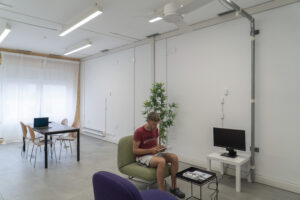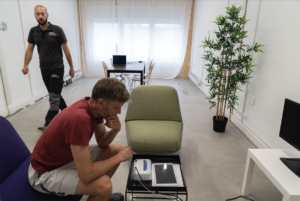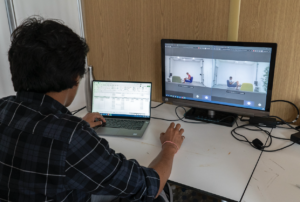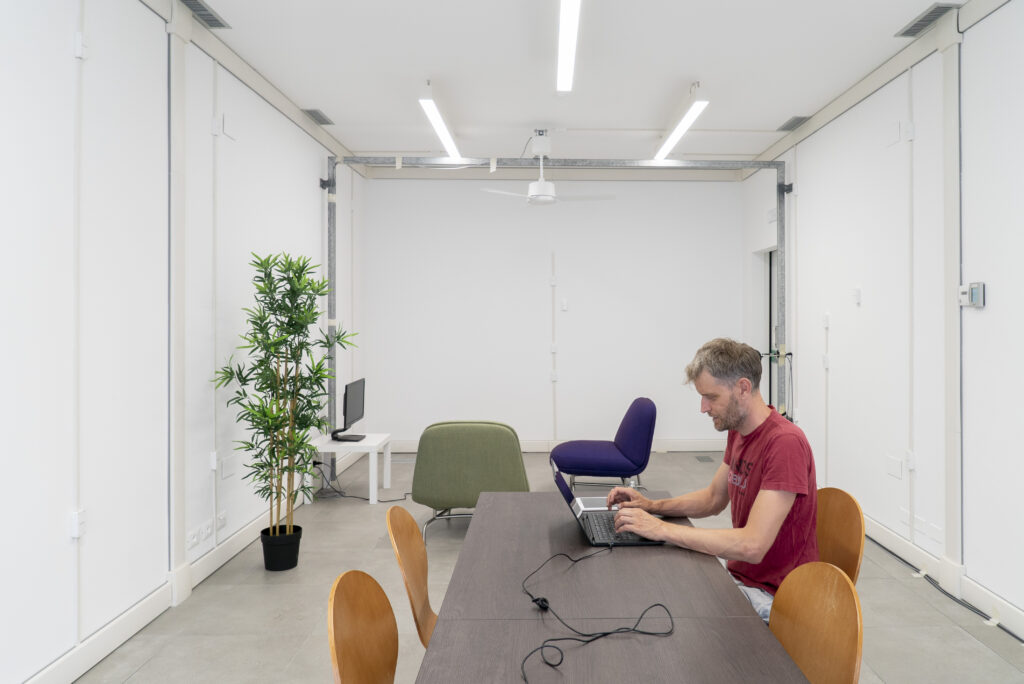In a warming climate, it is essential to curb the growing energy demand for comfort cooling in new and existing buildings while providing a reliable technological answer to the ever more intense heat waves.
Air movement can be an effective means to provide comfort cooling in warm environments as it increases the heat transfer from the human body to the environment. Furthermore, ceiling fans offer this cooling sensation at much lower energy cost than air conditioners. In addition to the impact on thermal comfort, elevated airspeed is proven to impact perceived air quality positively. Several studies suggest that air movement can be effectively used instead of air conditioning to provide cooling at temperatures slightly higher than 30°C, and more recent research proved that there are benefits up to 35°C.
As part of H2020 4RinEU project (grant agreement No 723829), it was developed an algorithm with the capability of automatically adapting a ceiling fan’s rotational speed based on the temperature and relative humidity values measured in the room. The algorithm was designed to ensure thermal comfort (90% satisfaction) in warm and hot conditions (26°C – 34°C) for different activity levels and was later implemented into a commercial residential ceiling fan produced by Vortice. As part of the Cultural-E project, researchers from Eurac, University of Venice and Vortice in the past summer performed a climatic chamber experimental study with human participants in order to test this user-centered technology.
The aim of the experimental campaign with human subjects was to analyse the effectiveness of ceiling fans, with manual or “smart” operation using the 4RinEU algorithm, to provide comfortable cooling conditions and to detail information that can be useful for further product development.
The main objectives were: (i) to test the effectiveness of the smart ceiling fan in terms of resulting comfort (thermal comfort, indoor air quality (IAQ) and acoustic comfort); (ii) to test comfort differences between a manual and an automatic mode of operation of the ceiling fan; (iii) to test comfort differences depending on the direction of rotation of blades (direct vs. reverse); (iii) to derive the (spatial) speed / (operative) temperature relationships for the different modes of control and blade rotation.
The research project involved 30 volunteers and was performed within the Eurac Research Façade System Interaction Lab (Bolzano, Italy), whose climatic chambers were set up as two residential environments (i.e. a living room) according to the aim of the test. Each participant experienced three different temperatures (27°C, 29 °C and 31 °C) and three different control and flow directions modes:
- Automatic direct: the algorithm chose the ceiling fan rotational speed; the air was moved from the ceiling toward the floor.
- Manual direct: the participants chose the ceiling fan rotational speed through a remote controller; the air was moved from the ceiling toward the floor.
- Manual reverse: the participants chose the ceiling fan rotational speed through a remote controller; the air was moved from the floor toward the ceiling.
While the environmental parameters were monitored, questionnaires about the environmental perception were submitted to participants. Objective and subjective measurements were processed to acquire information regarding the environmental and individual parameters to which participants were subjected. Each subjective response was associated with the environmental parameters relating to the timestamp at which the person started fulfilling the survey. It was so possible to have a data frame combining subjective information, instrumental measurements, environmental control parameters, and calculated parameters.
Overall, this study provided experimental evidence to say that the automatic control algorithm developed in H2020 4RinEU project is effective in providing comfort cooling in warm and hot indoor environments. When the fan is used in direct flow mode, the comfort level achieved with the automatic control is the same people experienced when they had manual control, but without requiring them to do any actions. The cooling effect of the fan was then modelled in dynamic energy simulations to show how to do so and to highlight the energy savings that can be achieved without jeopardizing thermal comfort.
More specific points are as follows.
- Ceiling fans are helpful to improve thermal comfort in residential buildings, especially for indoor operative temperatures of 27.64 °C or higher.
- The effectiveness of ceiling fans to provide comfortable cooling conditions in residential buildings gets better as the indoor operative temperature increases but after 31.5 °C the air movement does not seem to be sufficient to guarantee thermal satisfaction.
- The automatic algorithm works well in terms of resulting thermal comfort, guaranteeing 90% of satisfaction for temperatures up to 29.5 °C and still managing to guarantee satisfaction higher than 85% at higher temperatures.
- Also, from an indoor air quality (IAQ) point of view, the algorithm seems to be satisfactory, as there are always less than 18% unsatisfied people for all the surveyed temperature. Furthermore, the results show that the use of ceiling fan improves air quality satisfaction up to 3 points on the 7-point scale. This impact can mainly be attributed to the elevated air movement generated by the ceiling fan and the resulting perception of air freshness.
- There is no significant difference in people’s answers between manual and automatic control and the automatic algorithm can successfully predict what people would do in reality under the same indoor conditions. On the other hand, there is a difference in people’s answers between direct and reverse The reverse mode seems to work worse than the direct mode, giving thermal satisfaction ratings about 1 point lower.
- Direct modes allow higher neutral temperatures (25.9 °C in manual mode and 26.5 °C in automatic mode) than the reverse mode (24.76 °C).
- The ceiling fan speed that maximizes comfort increases as the indoor operative temperature increases (Speedcomfort = 47.2 % for 26-28°C, Speedcomfort = 55.1 % for 28-30 °C and Speedcomfort = 63.8 % for 30-32 °C).
More information can be found in the technologies section of our website and soon among our reports.






